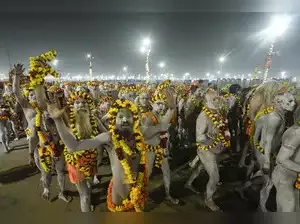The Naga sadhus, with their matted dreadlocks, ash-smeared bodies, and tridents, swords, and wooden staffs in hand—not as mere weapons but as emblems of devotion and ascetic strength—are the very essence of the Maha Kumbh.
For centuries, these warrior ascetics, tracing their lineage to Adi Shankaracharya, remained an exclusive brotherhood, largely drawn from privileged castes. However, this Maha Kumbh marked a shift in rigid social hierarchies.
For the first time in recorded history, over 20% of newly initiated Naga sadhus came from Dalit and tribal communities. Of the 8,715 seekers who renounced worldly life to embrace the Naga path, 1,850 belonged to Dalit or tribal backgrounds. In a parallel transformation, around 250 women embraced the austere life of Naga sadhvis, according to ToI report.
They came from the deep forests of Chhattisgarh, the riverine villages of Bengal, the mist-laden hills of Arunachal and Tripura, and the heartlands of MP. Leaving behind their homes, families, and former identities, they shaved their heads and performed their own Pind Daan - a ritual traditionally reserved for the departed. In that moment, they severed their ties with the old world, walking into an existence where caste and lineage no longer define them - only their spiritual pursuit does.
The Maha Kumbh officially concludes on February 26, but it is time to move on for the 13 akharas that define the essence of the grand congregation. And the first sign of their departure is the lowering of their respective flags. Following the final 'Amrit Snan' on Basant Panchami on Monday, the akharas have began leaving with a traditional 'kadhi pakoda' meal. The 13 akharas belong to different sects of 'sanyasis' (worshippers of Lord Shiva), bairagis (followers of Lord Ram and Lord Krishna), and udasins (devotees of the five deities).
Nearly 150 seers of the Bairagi sect's Panch Nirvani Akhara began leaving on Tuesday. About 35 are left. "Once Thakur ji (the deity) is ceremoniously moved, the 'dharma dhwaja' (religious flag) will be loosened," said Mahant Raju Das of Shri Panch Nirvani Ani Akhara, associated with Hanuman Garhi in Ayodhya.
The Naga sanyasis of Juna akhara will start their departure on February 7.
"Our akhara will hold the 'kadhi pakoda' feast on February 7 after which the seers will begin loosening the ropes of the 'dharma dhwaja' and start their departure," Juna akhara's international spokesperson Shri Mahant Narayan Giri told PTI,
He said they will first head to Kashi, where they will stay till Mahashivartri. There, they will participate in a grand procession, visit Kashi Vishwanath, play 'Masane Ki Holi' (a unique Holi celebration among ascetics), and take a ritual dip in the Ganga before proceeding to their respective monasteries and ashrams.
Sadhus of the Awahan and Panch Agni akharas will also hold similar processions in Kashmir before heading back to where they came from, Giri said.
Within the Bairagi akharas, some will travel to Ayodhya and others to Vrindavan. Members of the Udasin and Nirmal akharas will proceed towards Punjab, particularly Anandpur Sahib.
According to Giri, after Basant Panchami, the Maghi Purnima and Mahashivaratri holy dips at the Maha Kumbh are primarily for general devotees. The seers of the akharas do not stay back for these occasions.
Budget with ET
Tax calculator
For the first time in recorded history, over 20% of newly initiated Naga sadhus came from Dalit and tribal communities. Of the 8,715 seekers who renounced worldly life to embrace the Naga path, 1,850 belonged to Dalit or tribal backgrounds. In a parallel transformation, around 250 women embraced the austere life of Naga sadhvis, according to ToI report.
They came from the deep forests of Chhattisgarh, the riverine villages of Bengal, the mist-laden hills of Arunachal and Tripura, and the heartlands of MP. Leaving behind their homes, families, and former identities, they shaved their heads and performed their own Pind Daan - a ritual traditionally reserved for the departed. In that moment, they severed their ties with the old world, walking into an existence where caste and lineage no longer define them - only their spiritual pursuit does.
The Maha Kumbh officially concludes on February 26, but it is time to move on for the 13 akharas that define the essence of the grand congregation. And the first sign of their departure is the lowering of their respective flags. Following the final 'Amrit Snan' on Basant Panchami on Monday, the akharas have began leaving with a traditional 'kadhi pakoda' meal. The 13 akharas belong to different sects of 'sanyasis' (worshippers of Lord Shiva), bairagis (followers of Lord Ram and Lord Krishna), and udasins (devotees of the five deities).
Nearly 150 seers of the Bairagi sect's Panch Nirvani Akhara began leaving on Tuesday. About 35 are left. "Once Thakur ji (the deity) is ceremoniously moved, the 'dharma dhwaja' (religious flag) will be loosened," said Mahant Raju Das of Shri Panch Nirvani Ani Akhara, associated with Hanuman Garhi in Ayodhya.
The Naga sanyasis of Juna akhara will start their departure on February 7.
"Our akhara will hold the 'kadhi pakoda' feast on February 7 after which the seers will begin loosening the ropes of the 'dharma dhwaja' and start their departure," Juna akhara's international spokesperson Shri Mahant Narayan Giri told PTI,
He said they will first head to Kashi, where they will stay till Mahashivartri. There, they will participate in a grand procession, visit Kashi Vishwanath, play 'Masane Ki Holi' (a unique Holi celebration among ascetics), and take a ritual dip in the Ganga before proceeding to their respective monasteries and ashrams.
Sadhus of the Awahan and Panch Agni akharas will also hold similar processions in Kashmir before heading back to where they came from, Giri said.
Within the Bairagi akharas, some will travel to Ayodhya and others to Vrindavan. Members of the Udasin and Nirmal akharas will proceed towards Punjab, particularly Anandpur Sahib.
According to Giri, after Basant Panchami, the Maghi Purnima and Mahashivaratri holy dips at the Maha Kumbh are primarily for general devotees. The seers of the akharas do not stay back for these occasions.







